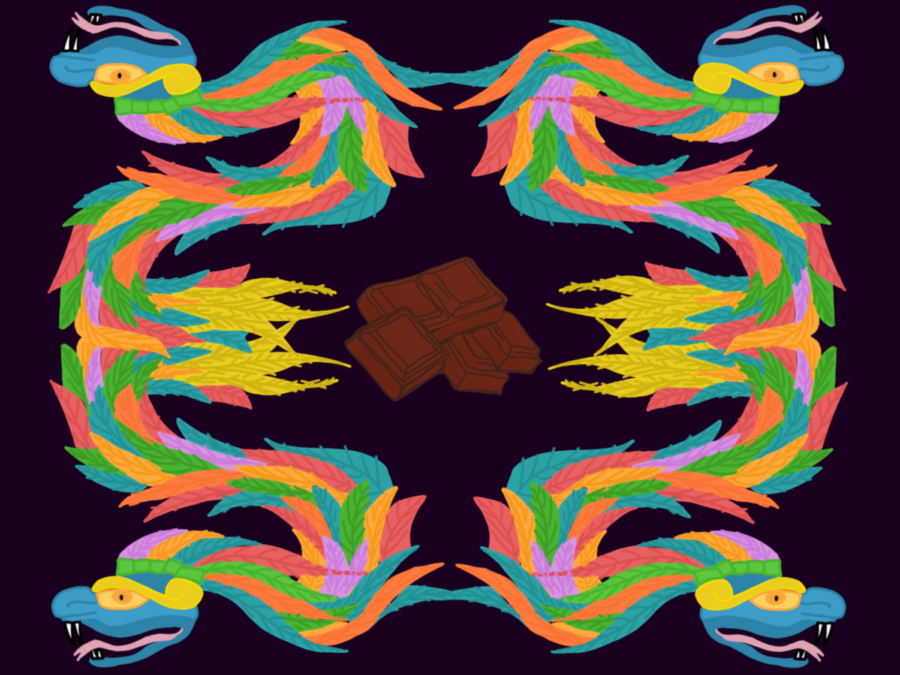The Bittersweet Reality Of How Chocolate Has Shaped History
September 27, 2019
When most people think of chocolate, little individually-wrapped candies come to their mind.
Amy Renchin, ‘22, says that “when [she] thinks of chocolate, [she] thinks of milk chocolate. [She] also pictures winter and drinking hot chocolate by a fireplace.”
However, throughout its 4,000 year history, chocolate was often consumed as a bitter drink with no sugar. Technically speaking, the term “chocolate” refers to anything produced or made from cacao beans. So where did chocolate come from, and how did chocolate change so much over the years?
The first signs of chocolate being eaten were found in Mesoamerica as early as 1900 B.C. According to Christopher Klein of The History Channel, the Olmec, Mayan and Aztec civilizations there believed chocolate had mythical and magical qualities. The Mayans even worshiped their god of cacao, Kukulkan. Chocolate was used for the most important rituals of birth, marriage and death, including when Aztecs sacrificed victims, according to Chloe Doutre-Roussel’s book, The Chocolate Connoisseur. The future victims of ritual sacrifices were often given gourds of chocolate before their executions as a sedative.
Chocolate spread to Europe in the 1500s when Spanish conquistadors, such as Hernán Cortés, returned from Mesoamerica with shipments of cacao trees. In Spain, chocolate maintained its luxurious qualities as it was expensive and reserved mostly for the wealthy, sweetened with cane sugar and cinnamon.
According to Amanda Fiegl, assistant of the Smithsonian Museum, by the 17th century, chocolate – still only in drink form – became fashionable throughout Europe. It was also thought to be nutritious and was even used for medicinal purposes.
To meet the growing demands of chocolate in Europe, European powers established colonial plantations in regions near the equator and used imported African slaves as laborers on plantations to maintain the chocolate production.
In the late 1700s, the invention of the steam engine finally made chocolate available for mass production, causing it to be cheaper and more available for the general public.
In 1828, the cocoa press was invented by Dutch chemist Coenraad Johannes van Houten. The cocoa press enabled much of the cocoa butter in the beans to separate from the bean itself, so the remainder of the cacao would be in a dense, dry cake. From there, the cake can be pulverized into a powder and treated with alkaline salts to eliminate the bitter taste. This product, cocoa powder, would then be mixed with other ingredients to make little solid pieces of chocolate, much like the chocolate squares we eat today.
The first chocolate bar was invented in 1847, by British chocolate company J.S. Fry & Sons.
Americans loved chocolate so much once they got their hands on it that during the Revolutionary War, it was included in the soldiers’ wages. Even today, chocolate is a powerful economic force, making up a 4 billion dollar industry in the USA. The average American consumes over 12 pounds of chocolate per year.
Even with all of this said, the production of chocolate today is generally a contentious issue. Many of the plantation workers today are not being paid fairly, especially those in Africa, and it is often mass-produced and processed using the lowest quality cacao.
Luckily, companies like Hershey’s are beginning to buy from smaller producers and higher quality cacao in general.
Alexandra Leaf, a self-described “chocolate educator” who runs a business called Chocolate Tours of New York City, states, “I see more and more American artisans doing incredible things with chocolate. Although, I admit that I tend to look at the world through cocoa-tinted glasses”.
Sadly, nobody knows if Leaf’s optimism will turn into reality or what chocolate will look like in a hundred years.






























